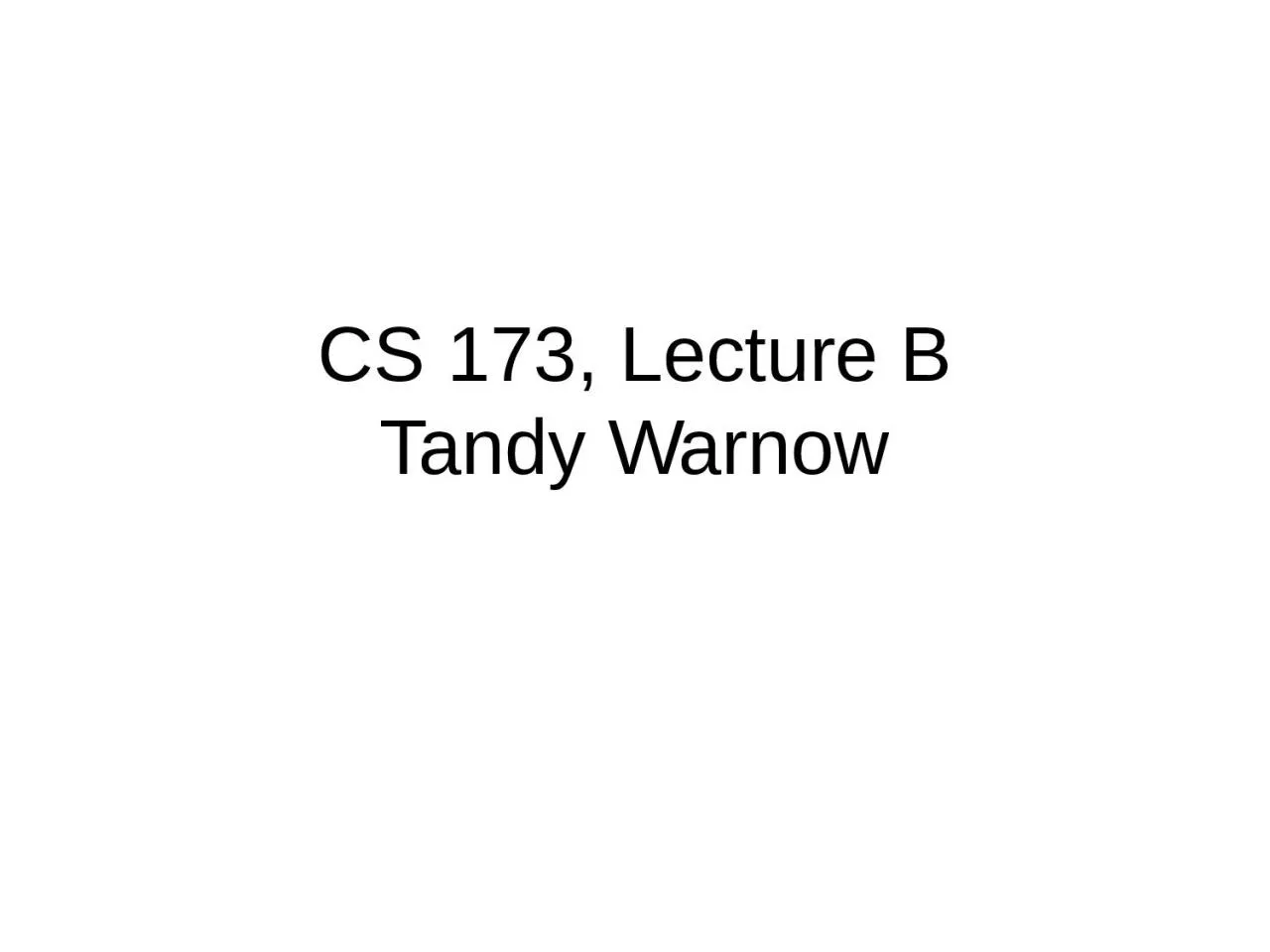

Topics for today Basics of combinatorial counting Applications to running time analysis Using combinatorial counting Evaluating exhaustive search strategies Finding maximum clique Determining if a graph has a 3coloring ID: 1001304
Download Presentation The PPT/PDF document "CS 173, Lecture B Tandy Warnow" is the property of its rightful owner. Permission is granted to download and print the materials on this web site for personal, non-commercial use only, and to display it on your personal computer provided you do not modify the materials and that you retain all copyright notices contained in the materials. By downloading content from our website, you accept the terms of this agreement.
1. CS 173, Lecture BTandy Warnow
2. Topics for todayBasics of combinatorial countingApplications to running time analysis
3. Using combinatorial countingEvaluating exhaustive search strategies:Finding maximum cliqueDetermining if a graph has a 3-coloringFinding a maximum matching in a graphDetermining if a graph has a Hamiltonial cycle or an Eulerian graph
4. Combinatorial countingHow many ways can you put n items in a row?pick k items out of n?pick subsets of a set of size n?assign k colors to the vertices of a graph?match up n boys and n girls?
5. TechniqueTo count the number of objects, design an algorithm to generate the entire set of objects. Check if each object is created exactly once (if not, you will have to do a correction later). The algorithm’s output can be seen as the leaves of a decision tree, and you can just count the leaves.
6. Putting n items in a rowAlgorithm for generating all the possibilities:For i=1 up to n, DOPick an item from S to go in position iDelete that item from the set SAnalysis: each way of completing this generates a different list. The number of ways of performing this algorithm is n!
7. Number of subsets of a set of size nAlgorithm to generate the subsets of a set S = {s1, s2, s3, …, sn}For i=1 up to n DO:Decide if you will include siAnalysis: each subset is generated exactly once, and the number of ways to apply the algorithm is 2x2x…x2=2n.
8. k-coloring a graphLet G have vertices v1, v2, v3, …, vnAlgorithm to k-color the vertices:For i=1 up to n DO:Pick a color for vertex viAnalysis: each coloring is produced exactly once, and there are kn ways of applying the algorithm.
9. Matching n boys and girlsAlgorithm:Let the boys be B1, B2, … Bn and let the girls be G1, G2, … Gn. For i=1 up to n DOPick a girl for boy Bi, and remove her from the setAnalysis: there are n ways to pick the first girl, n-1 ways to pick the second girl, etc., and each way produces a different matching.Total: n!
10. Picking k items out of nAlgorithm for generating all the possibilities:For i=1 up to k, DOPick an item from S to include in set ADelete that item from the set SThe number of ways of performing this algorithm is n(n-1)(n-2)…(n-k+1)=n!/(n-k)! But each set A can be generated in multiple ways - and we have overcounted!
11. Fixing the overcountingEach set A of k elements is obtained through k! ways of running the algorithm. As an example, we can generate {s1, s5, s3} in 6 ways, depending upon the order in which we pick each of the three elements.So the number of different sets is the number of ways of running the algorithm, divided by k!.The solution is n!/[k!(n-k)!]
12. Summary (so far)To count the number of objects, design an algorithm to generate the entire set of objects. Check if each object is created exactly once (if not, you will have to do a correction later). The algorithm’s output can be seen as the leaves of a decision tree, and you can just count the leaves.
13. SummaryNumber of orderings of n elements is n!Number of subsets of n elements is 2nNumber of k-subsets of n elements is n!/[k!(n-k)!]Number of k-colorings of a graph is kn
14. More advanced countingWhat is the number of k-subsets of a set S = {s1, s2, s3, … , sn} that do not include s1?What is the number of k-subsets of a set S = {s1, s2, s3, … , sn} that do include s1?What is the number of orderings of the set S in which s1 and s2 are not adjacent?What is the number of orderings of the set S in which s1 and s2 are adjacent?
15. New techniquesCount the complementDivide into disjoint cases, and count each case
16. ExampleWhat is the number of k-subsets of a set S = {s1, s2, s3, … , sn} that do not include s1?Solution: same as number of k-subsets of {s2, s3, … , sn}. So (n-1)!/[(n-1-k)!k!]
17. ExampleWhat is the number of k-subsets of a set S = {s1, s2, s3, … , sn} that do include s1?Solution: same as the number of (k-1)-subsets of {s2, s3, … , sn}, so (n-1)!/[(n-k)!(k-1)!]
18. ExampleWhat is the number of orderings of the set S in which s1 and s2 are adjacent?Solution: two cases: Case 1) s1 followed by s2 Case 2) s2 followed by s1Same number of each type. Easy to see that there are (n-1)! of each type, so 2(n-1)! in total
19. ExampleNumber of orderings of the set S in which s1 and s2 are not adjacent?This is the same as n!-2(n-1)!
20. Using combinatorial countingEvaluating exhaustive search strategies:Finding maximum cliqueDetermining if a graph has a 3-coloringFinding a maximum matching in a graphDetermining if a graph has a Hamiltonian cycle or an Eulerian tour